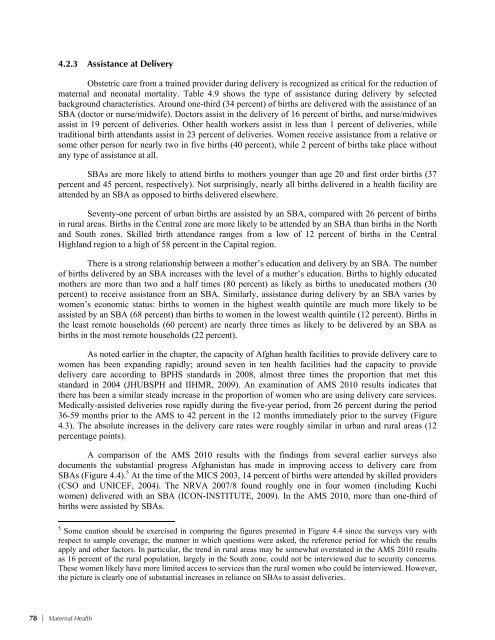Afghanistan Mortality Survey 2010 - Measure DHS
Afghanistan Mortality Survey 2010 - Measure DHS
Afghanistan Mortality Survey 2010 - Measure DHS
- No tags were found...
Create successful ePaper yourself
Turn your PDF publications into a flip-book with our unique Google optimized e-Paper software.
4.2.3 Assistance at DeliveryObstetric care from a trained provider during delivery is recognized as critical for the reduction ofmaternal and neonatal mortality. Table 4.9 shows the type of assistance during delivery by selectedbackground characteristics. Around one-third (34 percent) of births are delivered with the assistance of anSBA (doctor or nurse/midwife). Doctors assist in the delivery of 16 percent of births, and nurse/midwivesassist in 19 percent of deliveries. Other health workers assist in less than 1 percent of deliveries, whiletraditional birth attendants assist in 23 percent of deliveries. Women receive assistance from a relative orsome other person for nearly two in five births (40 percent), while 2 percent of births take place withoutany type of assistance at all.SBAs are more likely to attend births to mothers younger than age 20 and first order births (37percent and 45 percent, respectively). Not surprisingly, nearly all births delivered in a health facility areattended by an SBA as opposed to births delivered elsewhere.Seventy-one percent of urban births are assisted by an SBA, compared with 26 percent of birthsin rural areas. Births in the Central zone are more likely to be attended by an SBA than births in the Northand South zones. Skilled birth attendance ranges from a low of 12 percent of births in the CentralHighland region to a high of 58 percent in the Capital region.There is a strong relationship between a mother’s education and delivery by an SBA. The numberof births delivered by an SBA increases with the level of a mother’s education. Births to highly educatedmothers are more than two and a half times (80 percent) as likely as births to uneducated mothers (30percent) to receive assistance from an SBA. Similarly, assistance during delivery by an SBA varies bywomen’s economic status: births to women in the highest wealth quintile are much more likely to beassisted by an SBA (68 percent) than births to women in the lowest wealth quintile (12 percent). Births inthe least remote households (60 percent) are nearly three times as likely to be delivered by an SBA asbirths in the most remote households (22 percent).As noted earlier in the chapter, the capacity of Afghan health facilities to provide delivery care towomen has been expanding rapidly; around seven in ten health facilities had the capacity to providedelivery care according to BPHS standards in 2008, almost three times the proportion that met thisstandard in 2004 (JHUBSPH and IIHMR, 2009). An examination of AMS <strong>2010</strong> results indicates thatthere has been a similar steady increase in the proportion of women who are using delivery care services.Medically-assisted deliveries rose rapidly during the five-year period, from 26 percent during the period36-59 months prior to the AMS to 42 percent in the 12 months immediately prior to the survey (Figure4.3). The absolute increases in the delivery care rates were roughly similar in urban and rural areas (12percentage points).A comparison of the AMS <strong>2010</strong> results with the findings from several earlier surveys alsodocuments the substantial progress <strong>Afghanistan</strong> has made in improving access to delivery care fromSBAs (Figure 4.4). 5 At the time of the MICS 2003, 14 percent of births were attended by skilled providers(CSO and UNICEF, 2004). The NRVA 2007/8 found roughly one in four women (including Kuchiwomen) delivered with an SBA (ICON-INSTITUTE, 2009). In the AMS <strong>2010</strong>, more than one-third ofbirths were assisted by SBAs.5 Some caution should be exercised in comparing the figures presented in Figure 4.4 since the surveys vary withrespect to sample coverage, the manner in which questions were asked, the reference period for which the resultsapply and other factors. In particular, the trend in rural areas may be somewhat overstated in the AMS <strong>2010</strong> resultsas 16 percent of the rural population, largely in the South zone, could not be interviewed due to security concerns.These women likely have more limited access to services than the rural women who could be interviewed. However,the picture is clearly one of substantial increases in reliance on SBAs to assist deliveries.78 | Maternal Health








![Obtaining Informed Consent for HIV Testing [QRS4] - Measure DHS](https://img.yumpu.com/49850117/1/190x245/obtaining-informed-consent-for-hiv-testing-qrs4-measure-dhs.jpg?quality=85)








